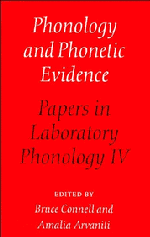Book contents
- Frontmatter
- Contents
- List of contributors
- Acknowledgments
- 1 Introduction
- I Features and Perception
- 2 Intermediate properties in the perception of distinctive feature values
- 3 A double-weak view of trading relations: comments on Kingston and Diehl
- 4 Speech perception and lexical representation: the role of vowel nasalization in Hindi and English
- 5 Processing versus representation: comments on Ohala and Ohala
- 6 On the status of redundant features: the case of backing and rounding in American English
- 7 The perceptual basis of some sound patterns
- II Prosody
- III Articulatory Organization
- Subject index
- Index of names
- Index of languages
7 - The perceptual basis of some sound patterns
Published online by Cambridge University Press: 03 May 2011
- Frontmatter
- Contents
- List of contributors
- Acknowledgments
- 1 Introduction
- I Features and Perception
- 2 Intermediate properties in the perception of distinctive feature values
- 3 A double-weak view of trading relations: comments on Kingston and Diehl
- 4 Speech perception and lexical representation: the role of vowel nasalization in Hindi and English
- 5 Processing versus representation: comments on Ohala and Ohala
- 6 On the status of redundant features: the case of backing and rounding in American English
- 7 The perceptual basis of some sound patterns
- II Prosody
- III Articulatory Organization
- Subject index
- Index of names
- Index of languages
Summary
By invitation of the editors, the following is a summary of remarks I offered at the Fourth Conference in Laboratory Phonology on the subject of language change and its causes. They were stimulated principally by observations by Tore Janson.
Features: positive and/or negative correlates?
Janson stated that “a credible model for perceptual retrieval should contain only such features that can be detected in the auditory signal. This excludes features … that have no positive phonetic correlates at all.” There are many cases where this is undoubtedly a sensible principle, but I would discourage an interpretation that denies the distinctive character of absence of a phonetic event in cases where two (or more) speech sounds are similar except for presence vs. absence of the phonetic event as a typical co-occurring feature. For example, [t, k] usually have prominent bursts but [p] does not since it has no downstream resonator. An [i] is similar to an [u] in F1 and F3 but only the former has a very high F2.
An experiment by Ohala & Shriberg (1990) provides evidence for this. The experiment involved listeners' perception of filtered vowels. Simplifying somewhat, their study had listeners identify 11 short (85 ms) American English vowels that had been excised from the speech of four male speakers. Each vowel was presented after a short precursor sentence I will now say the word … by the same speaker who produced the vowel. Both precursor sentence and the stimulus vowel could be separately or together low-pass filtered (at 1000 Hz) (LP), or presented full-band.
- Type
- Chapter
- Information
- Phonology and Phonetic EvidencePapers in Laboratory Phonology IV, pp. 87 - 92Publisher: Cambridge University PressPrint publication year: 1995
- 6
- Cited by



